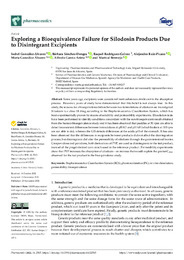Por favor, use este identificador para citar o enlazar este ítem:
https://hdl.handle.net/11000/34609Registro completo de metadatos
| Campo DC | Valor | Lengua/Idioma |
|---|---|---|
| dc.contributor.author | González Álvarez, Isabel | - |
| dc.contributor.author | Sánchez-Dengra, Bárbara | - |
| dc.contributor.author | Rodríguez Gálvez, Raquel | - |
| dc.contributor.author | Ruiz Picazo, Alejandro | - |
| dc.contributor.author | González Álvarez, Marta | - |
| dc.contributor.author | García Arieta, Alfredo | - |
| dc.contributor.author | Bermejo, Marival | - |
| dc.contributor.other | Departamentos de la UMH::Ingeniería | es_ES |
| dc.date.accessioned | 2025-01-16T17:59:02Z | - |
| dc.date.available | 2025-01-16T17:59:02Z | - |
| dc.date.created | 2022-11-23 | - |
| dc.identifier.citation | Pharmaceutics 2022, 14(12), 2565 | es_ES |
| dc.identifier.issn | 1999-4923 | - |
| dc.identifier.uri | https://hdl.handle.net/11000/34609 | - |
| dc.description.abstract | Some years ago, excipients were considered inert substances irrelevant in the absorption process. However, years of study have demonstrated that this belief is not always true. In this study, the reasons for a bioequivalence failure between two formulations of silodosin are investigated. Silodosin is a class III drug according to the Biopharmaceutics Classification System, which has been experimentally proven by means of solubility and permeability experiments. Dissolution tests have been performed to identify conditions concordant with the non-bioequivalent result obtained from the human bioequivalence study and it has been observed that paddles at 50 rpm are able to detect inconsistent differences between formulations at pH 4.5 and pH 6.8 (which baskets at 100 rpm are not able to do), whereas the GIS detects differences at the acidic pH of the stomach. It has also been observed that the differences in excipients between products did not affect the disintegration process, but disintegrants did alter the permeability of silodosin through the gastrointestinal barrier. Crospovidone and povidone, both derivatives of PVP, are used as disintegrants in the test product, instead of the pregelatinized corn starch used in the reference product. Permeability experiments show that PVP increases the absorption of silodosin—an increase that would explain the greater Cmax observed for the test product in the bioequivalence study. | es_ES |
| dc.format | application/pdf | es_ES |
| dc.format.extent | 12 | es_ES |
| dc.language.iso | eng | es_ES |
| dc.publisher | MDPI | es_ES |
| dc.rights | info:eu-repo/semantics/openAccess | es_ES |
| dc.rights | Attribution-NonCommercial-NoDerivatives 4.0 Internacional | * |
| dc.rights.uri | http://creativecommons.org/licenses/by-nc-nd/4.0/ | * |
| dc.subject | Biopharmaceutics Classification System (BCS) | es_ES |
| dc.subject | pharmacokinetics (PK) | es_ES |
| dc.subject | in vitro dissolution | es_ES |
| dc.subject | permeability | es_ES |
| dc.subject | bioequivalence | es_ES |
| dc.subject.other | CDU::6 - Ciencias aplicadas::62 - Ingeniería. Tecnología | es_ES |
| dc.title | Exploring a Bioequivalence Failure for Silodosin Products Due to Disintegrant Excipients | es_ES |
| dc.type | info:eu-repo/semantics/article | es_ES |
| dc.relation.publisherversion | https://doi.org/10.3390/pharmaceutics14122565 | es_ES |

Ver/Abrir:
pharmaceutics-14-02565.pdf
2,02 MB
Adobe PDF
Compartir:
 La licencia se describe como: Atribución-NonComercial-NoDerivada 4.0 Internacional.
La licencia se describe como: Atribución-NonComercial-NoDerivada 4.0 Internacional.
.png)